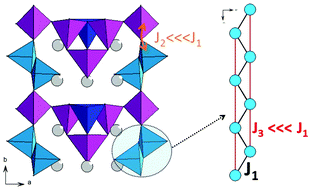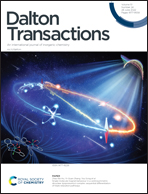Preparation, characterization and DFT+U study of the polar Fe3+-based phase Ba5Fe2ZnIn4S15 containing S = 5/2 zigzag chains†
Abstract
The polar magnetic chalcogenide phase Ba5Fe2ZnIn4S15 was synthesized and its structure was solved by single crystal XRD. It is the first member with a 3d magnetic metal (Fe3+) in the Pb5ZnGa6S15-type structure family of wide bandgap materials with non-linear optical properties. The three-dimensional framework possesses a low dimensional magnetic character through the presence of weakly interacting zig-zag chains made of corner-sharing FeS4 tetrahedra forming chain 1, [FeS2]−∞. The latter chains are separated by InS4 tetrahedra providing weak magnetic super-super exchanges between them. The framework is also constituted by chain 2, [In3Zn1S9]7−∞ (chain of T2-supertetrahedra) extended similarly to chain 1 along the direction c and connected through InS4 tetrahedra. Symmetry analysis shows that the intrinsic polarization observed in this class of materials is mostly due to the anionic framework. Preliminary magnetic measurements and density functional theory calculations suggest dominating antiferromagnetic interactions with strong super-exchange coupling within the Fe-chains.

- This article is part of the themed collection: Open Access in Dalton Transactions


 Please wait while we load your content...
Please wait while we load your content...